Family : Paridae

Text © Dr. Gianfranco Colombo

English translation by Mario Beltramini

Talkative, colourful, always moving, the great tit (Parus major) never goes unnoticed © Antino Cervigni
The well known Great tit (Parus major Linnaeus, 1758), belongs to the order of the Passeriformes and to the family of the Paridae and is one of the most common small birds in Europe together with its similar Eurasian blue tit (Cyanistes caeruleus), species once assigned to the same genus Parus.
Never a common name was so guessed in describing the characteristics of a small bird; in only one term is concentrated all its enormous vitality. To say cinciallegra (great tit in Italian) even for a layman, immediately gives the idea of how can be the behavior of this bird, inspiring at the same time an innate sympathy without even ever having seen it or unable to recognize it among others.
Contrarily to those who know it, to say “allegra” (gay, in Italian) would seem even to lessen its characteristics, because actually its everlasting agitation, would deserve a much stronger term, more vigorous, closer to the restlessness than to a simple gaiety. But it is not just the movement that distinguishes it from the similars, in fact we have to add the continuous good mood that it infuses in any season you meet it, with its innate talkativeness and the continuous emission of sounds and songs it invariably spreads whenever it comes on stage.
From a simple “gne gne gne” of greeting that accentuates and accelerates depending on the typology of alarm and danger, to its spring song that has even entered the local folklore. In the very first spring its unceasing “cirpì cirpì cirpì” rejoices every corner of the country and invites the countryman, as occurs, citing it in the Friulian language, to “potare potare potare” (to prune, prune, prune) as this is the meaning, advising that the time to put hands in the orchard has now come.
This small bird, together with the blue tit, has displayed during the last decades a good increase of the population and a consolidation of the occupied areas in particular of the anthropized ones. It has been ascertained that this increase is due also to the habit of placing in gardens an public parks, nest boxes and mangers. It has happened, in small-scale, what happened with the rock doves (Columba livia) now become permanent residents of our cities and who live almost exclusively with food offered by the population.
The strong adaptability shown in diversifying the feeding during the winter period, has allowed it to receive a remarkable help for overcoming the bad season, avoiding the normal winter massacre dictated by the natural selection. The great tit has also a record of superiority against other birds, having proved with scientific tests, what in nature already hinted with its innate and insuperable curiosity, virtue that has automatically resulted in pure intelligence.
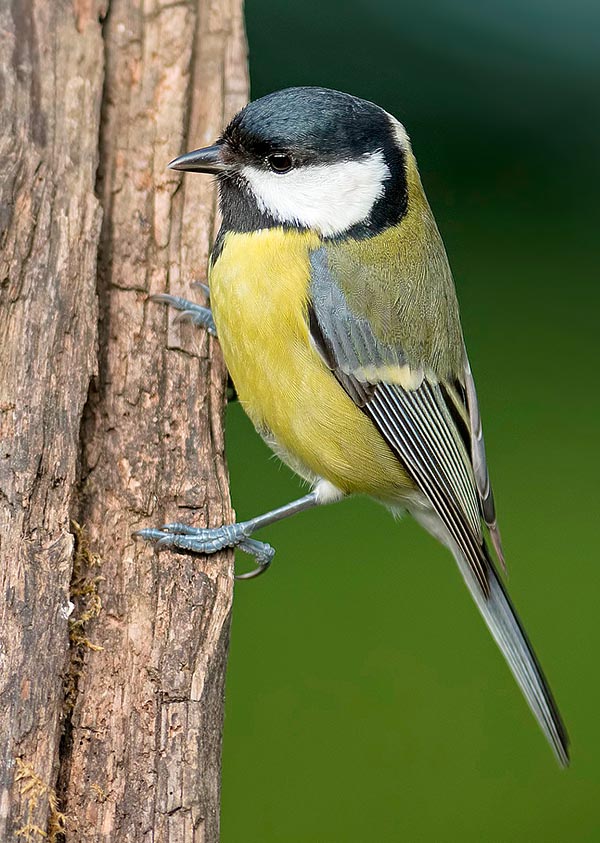
Curious, intelligent, ready to learn and to teach © Antino Cervigni
It has been seen operating with a strong keenness to recover the food hidden in particular and at times intriguing mechanisms, finding almost human solutions to solve the tests this which it had been submitted. It should never be forgotten that it was just in England, still in the 50’s of the last century, that this bird did show how much ample was its intelligence.
Together with the blue tit it had learnt to pierce with its small, sharp but rather robust bill, the tin foil closing the typical milk bottles with wide neck left by the milkman early in the morning at the door of the houses, then sucking the outcropping cream that for them became an indispensable delicacy. In some peripheral London areas they even came to a percentage of the 80% of bottles made subject to this treatment. The mechanism was diffused and learnt by all the populations of tits of the cities involved in this initiative, thus showing an unthinkable capacity of learning.
Finally, we must add another very important characteristic for this small bird. The great tit is an avid insectivore during the summer season and is a major consumer of larvae and caterpillars of small lepidopterans, particularly those of the Winter moth (Operophtera brumata), so much that they have calculated that in one single productive phase, corresponding to the about three weeks necessary for growing the numerous progeny, a couple can catch not least than 7000 caterpillars.
For this reason in the orchards and in the vineyards, places notoriously subject to a very strong biological impact due to the at times indiscrimante use of insecticides and of pesticides are placed nest boxes dedicated to them, in order to verify the consequences on the quality of the environment. Practically, the great tit is considered as a winged cavy.
The scientific name etymology has a Latin derivation with complicated interpretations that have gone through modifications, diminutives and also abbreviations. Linnaeus took note of the genus Parus. The etymology of the scientific name has a Latin derivation with complicated interpretations that have gone through modifications, interpretations, diminutives and also abbreviations. Linnaeus took note of the genus major, to distinguish it from the other smaller congeners.
In Europe it is called: Eurasian Great Tit in English, Cinciallegra in Italian, Kohlmeise in German, Carbonero común in Spanish, Mésange charbonnière in French and Chapim real in Portuguese. The Italian common names are many seen the presence of this small bird in every corner of the country. It is worthy to cite some of them, all gotten from the distorsion of the Latin scientific name such as parasȫla, parussola, parasciula, parridda, parnisola without forgetting the fanciful names used in other regions, getting in the south of the peninsula, cincipottola, perlonza e cucciumannedda.
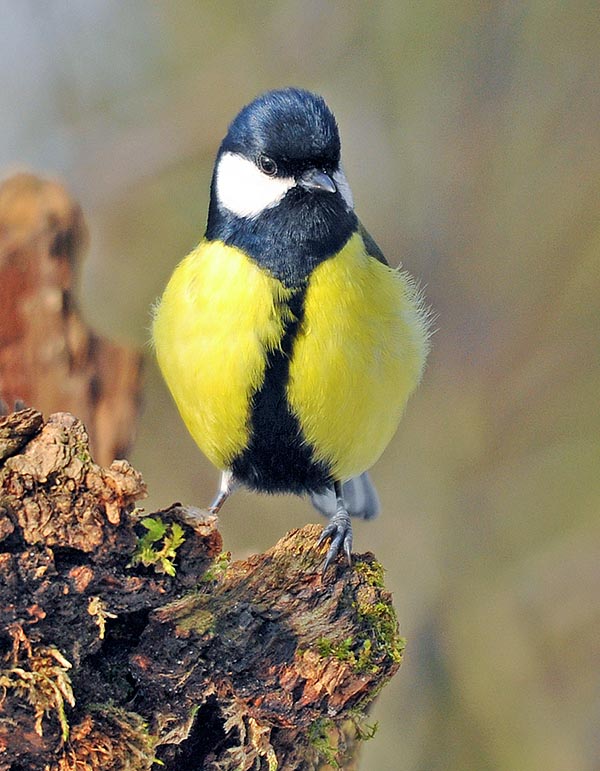
With the no less smart blue tit, having discovered years ago in England that piercing with the bill the foil caps of the milk bottles, left on the house door steps, there was some good cream to suck … and soon all other tits had learnt to do the same with even, in some quarters, the 80% of holed caps © G. Colombo
The name cincia is onomatopoeic and comes from the customary and rhythmical cink cink cink emitted continuously. Like all birds linked to the human presence, also the great tit has its place in the lyrical poetry with a hint in Giovanni Pascoli’s Canti di Castelvecchio where, talking of his refuge of Barga and of the peace around him, he recites:
“Leave me still here to stay – among so much movement of wings and leaves; and hear the cock who from a farm – calls, and from another the other replies – and, when elsewhere the soul is looking, the screams of a brawling tit”.
He too knew it well!
Zoogeography
The range occupied by the great tit is extremely wide and covers all Europe, excluding only Iceland, most of Asia and the Mediterranean coasts of north-western Africa.
More in detail, in Asia it does not live in the central steppe and desert territory, Iran and Arabian peninsula, the northern plains of India and the eastern part of the Indonesian archipelago.
In Europe and in Italy the species is quite diffused and present in any place, being the great tit very adaptable to every environment and also to the sudden modifications of agriculture, unlike other species that have deeply suffered from this.
In the rural areas but now also in the cities and in thickly inhabited zones, this species has spread remarkably taking the best advantage from any possible opportunity. It is thickly distributed at the low altitudes but often penetrates into the mountain valleys reaching at times the high hill.
Such a vast territory has originated a high number of subspecies, presently at the level of some tens but this is a value that by sure will increase in future thanks to extensive studies about the specific DNA. Not all subspecies have been officially recognized or are on the way of recognition.
The main ones interesting the European area are the Parus major newtoni, typical of the British Isles, the Parus major major of the rest of Europe and the Near East, the Parus major corsus of the south west of the Iberian Peninsula and Corsica, the Parus major mallorcae typical of the Balearic Islands, Parus major ecki of Sardinia, the Parus major aphrodite of South Italy and Greek islands and the Parus major niethammeri that appears to be present only in the island of Crete. The other and numerous subspecies are Asian and are located in particular and at times remote territories.

It is the first to colonize the nest boxes of the gardens attacking the competitors, in this instance a blue tit not less intelligent but smaller © Alain Ghignone
The great tit is not a true migrant and does not engage in long range trips excepting small seasonal and local errations, due to the research of feeding sites or of descents from higher altitudes. Conversely, it is subject, in particular in the northern ranges and in seasons particularly prolific, to massive irruptions towards more southerly territories but these are fairly occasional and little recurring instances.
Ecology-Habitat
There is not a particular habitat for the great tit as its adaptability has led it to occupy and accept every type of environment. However, we can say that this bird does not love thick woods, expanses of conifers and strongly treed areas, does not love the high altitudes getting to reach only occasionally the 1500/1600 m of altitude, as well as desert and particularly dry areas.
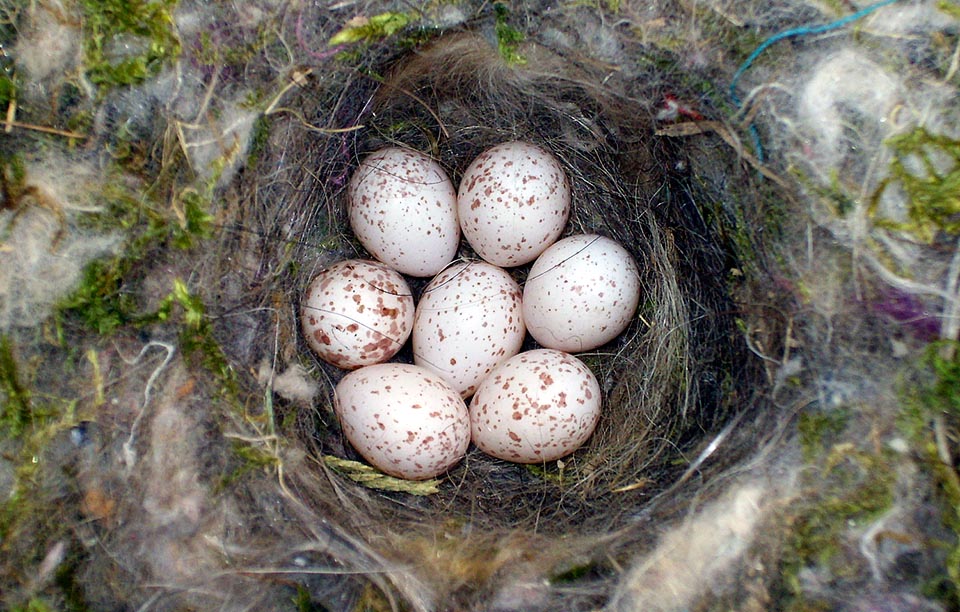
Any hole is good for the soft cup shaped nest of Parus major, filled with a high quantity of moss, hairs, wool, locks and feathers. Even if much predated by sparrowhawk, squirrels, wesels and great spotted woodpecker, it is not endangered due to the great prolificacy with two depositions per year with 7-15 eggs brooded by the female © Museo Civico di Lentate su Seveso
Practically, the great tit lives where the insects are abundant and visible, consequently the vegetation must be such as to ensure a constantly feeding reservoir.
It commonly lives in the inhabited centres appropriately taking advantage of the protection against those habitual predators that do not dare to get close to this environment, even if new species of aggressors, in particular the domestic cats, are still there in ambush. However, it is an arboreal bird and for this it goes to the ground only occasionally and for very short time.
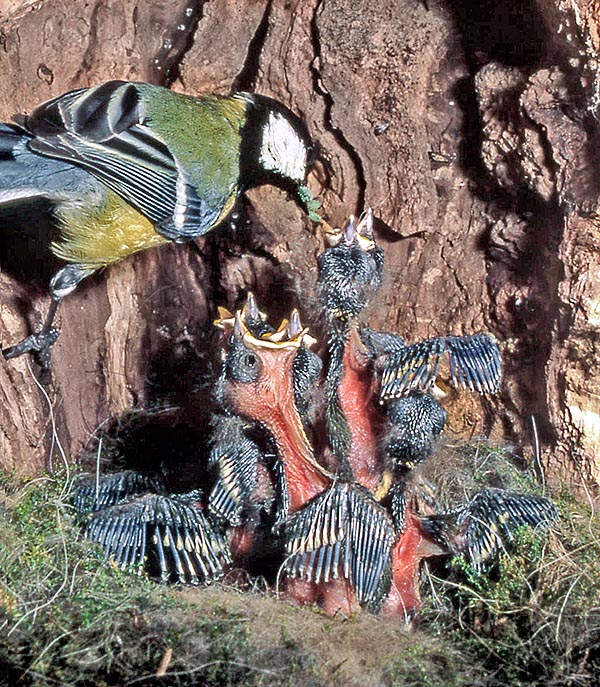
Chicks, very hungry, are a bottomless pit and it’s a continuous parents going back and forth to feed them © Museo Civico di Lentate su Seveso
During the winter it is continuously wandering inside its territory forming mixed bands even of some tens of birds, with Blue tits (Cyanistes caeruleus), with Common Chiffchaffs (Phylloscopus collybita), with Long-tailed tits (Aegithalos caudatus), with Goldcrests (Regulus regulus) and with the Firecrests (Regulus ignicapillus).
They, together, sift practicaly every tree or shrub looking for the last remaining insects.
Morpho-physiology
The dimensions of the great tit, albeit called major, are surely not exciting.
It is a 15 cm long small bird, weighing 17 g and with a wingspan of about 20 cm.
It has however a lively and gay livery showing a totally lemon yellow chest crossed centrally by a black band that starting from the throat, where creates an ample gag and going around the neck a showy collar, ends in the abdomen.
In the male this stripe is much more marked than in the female that, otherwise, would be practically similar.
The cheeks are very white and the head is crowned by a black hood that covers the eyes and ends in the ocular line but that, continuing backward, joins on the nape leaving exposed a white occipital spot.
The shoulders and the coverts are greenish grey ending close to the junction of the remiges, with a white transversal bar as delimitation.
The remiges and the tail are instead blackish grey with feathers having white barbs that draw a well visible alar bar. The eyes, the bill and the legs are black.
The bill of the great tit, even if insectivorous, has a remarkable piercing strength, so much that it is used for holing the hard integument of encapsulated fruits and the rigid involucres of winter berries. Often it is seen beating strongly a small hazelnut stuck in a bark wrinkle, with the vehemence and the insistence of a real woodpecker.
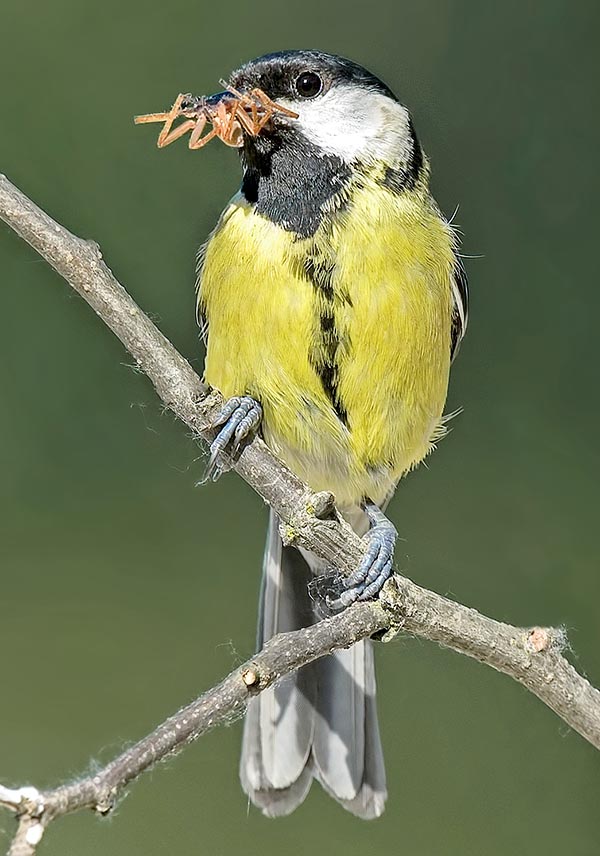
Unusual forkful of spaghetti? No, they are the bent legs of an unwary spider just seized © Antino Cervigni
Ethology-Reproductive Biology
The great tit usually makes two broods per year with a remarkable quantity of eggs demonstrating the great prolificacy of the species but conversely of the strong mortality of chicks during the juvenile phase.
The nest is placed in any hole and at any level of the ground. It can be an old nest of woodpecker or on ground level in a stone wall, in a crack of an old wall or in a mailbox, in a cemetery small light base or in a nest box.
The nest box is terribly attractive for the great tit and is quickly occupied as soon as positioned, preceding by far the action of other birds. It is not rare then to see great tits throwing outside the material that other precocious birds had put while occupying the box and evict them resolutely.
The nest is formed by a remarkable quantity of moss, hairs, wool, locks and feathers and is very soft. Inside this mass is formed a little deep cup where are laid 7 to 15 eggs of cream colour, finely and diffusely spotted of reddish brown. The brooding is done by the female only for about two weeks whilst the care and the assistance of the progeny is borne by both partners.
Stunning are the frequency and the quantity of beakfuls necessary for breeding such a numerous and hungry progeny, therefore the parents spend almost totally the day in a continuous back and forth for feeding them and for a period of not less than of three weeks for each brood.
By the first flights the young are followed still for some days by the parents even if in the mean time the female begins already a new deposition.
The great tit is an insatiable insectivore in summer and during the period of the growth of the progeny whilst becomes partially vegetarian during the winter. It nourishes of caterpillars and spiders, of terrestrial and flying insects but also of seeds, berries and fruits when available. No one would imagine that a such gay and nice small bird hides instead a short-tempered and quarrelsome character. The great tit is an innate brawler, a very aggressive small bird with all, whether conspecifics or of other species, even if bigger.
It is easy to note its behaviour at the mangers prepared in winter for the small birds of your own garden. It gives no rest to anyone with its rapidity of movements and speed in flight, seizes anyone just to conquer a tasty morsel. It is as naughty as the Robin (Erithacus rubecula) just as a proof that not always few centimetres do mean much fear nor kindness to others.

The great tits are insectivorous and a couple catches about 7000 caterpillars per brood, but in winter they eat also berries and seeds © Gianfranco Colombo
Also during the nesting the great tit displays a strong territoriality and getting close to the nest by consimilar causes an immediate and hard reaction. The great tit has several predators, first of all the Sparrowhawk (Accipiter nisus) its archenemy, then red squirrels (Sciurus vulgaris), weasels (Mustela nivalis) and, strangely enough, also the great spotted woodpecker (Dendrocopos major) but in a very particular way. It is known that the woodpecker looks for its food under the bark of the trees, auscultating as a doctor with the stethoscope, every smallest noise emitted by the movement of the underlying larvae. It’s easy then to hear inside the trunk the chicks of a great tit peeping and stirring in the nest. The outcome is terrible. As a matter of fact we can see frequently on the trunks, just under the holes used by the great tit or on the other side but in correspondence to the nest, some small holes badly dug but sufficient for the woodpecker to insert the head and collect one by one all the chicks present.
The species is not considered as in danger.
→ To appreciate the biodiversity within PASSERIFORMES please click here.
